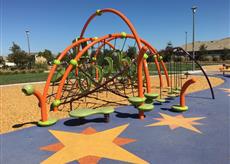
Poured In Place Rubber Surfacing
Author: Austin Stanfel
Poured-in-place (PIP) rubber surfacing has seen a huge upward swing in popularity, being the go-to material for school playgrounds, parks, and other recreational outdoor spaces. It is both safe and versatile, as well as very adaptable in terms of thickness, colour, and design, meaning it has a vast range of applications in everyday life.
The health-and-safety benefits of any surfacing for children’s play areas and outdoor spaces is obviously one of the most important factors. Because it is a unitary surface, PIP surfacing provides an area which is safe for and accessible to wheelchair users and small children, unlike gravel, woodchips, or conventional paving. It is unlikely to cause tripping due to loose or damaged material, and offers a seamless, resilient surface for all users.
PIP is generally laid on a gradual slope, promoting drainage, which means its surface is less likely to be slippery or wet, and due to the porous nature, it naturally has some anti-slip properties. It is also is very low-maintenance, not requiring any loose surfacing to be replaced, or any tiles to be maintained, and therefore not causing health-and-safety risks if the area is not being looked after.
As it is a popular choice for children’s play areas, shock-absorbency is obviously another major factor, particularly in areas with trees or climbing equipment, which might pose a falling hazard. Areas with bikes and skateboards also require high safety standards for their users. PIP rubber surfacing is poured in two layers; it has an impact-absorbing layer, which is then covered by a decorative layer. This means that it can be adapted to a range of uses, with thicker shock-absorbing layers for areas with high equipment. The thickness needed is directly quantifiable, making it easy to calculate and ensure maximum safety.
Furthermore, there are no loose parts for children to choke on, suck, or throw, and the rubber was shown to cause no skin irritation when tested by the California Integrated Waste Management Board. The smooth surface makes clean-up easy; it is simply a case of removing debris (such as leaves or litter) from the surface with a broom or leaf-blower. This makes it simple and quick to keep the space clean and user-friendly, as well as safe for young children; there is unlikely to be broken glass or metal left unnoticed on the site. Maintenance is kept to a minimum by virtue of the product’s design. PIP’s durability and resilience adds another attraction, offering up to ten years’ lifespan, depending on use.
Finally, the aesthetic flexibility of PIP surfacing makes it suitable for a wide variety of spaces and users; it can be brightly patterned in play areas for children, or subtle and subdued to blend in with parks or nice landscapes.
Overall, PIP rubber surfacing cannot be challenged for what it offers users: safety, accessibility, durability, and visual appeal, as well as low-maintenance. The lower layer can be made of recycled rubber, offering an environmental benefit, and the decorative top layer means that PIP surfacing can be applied in a huge range of outdoor places, for all ages.

